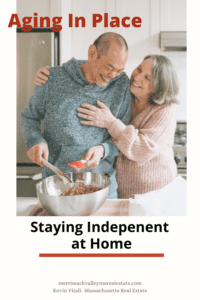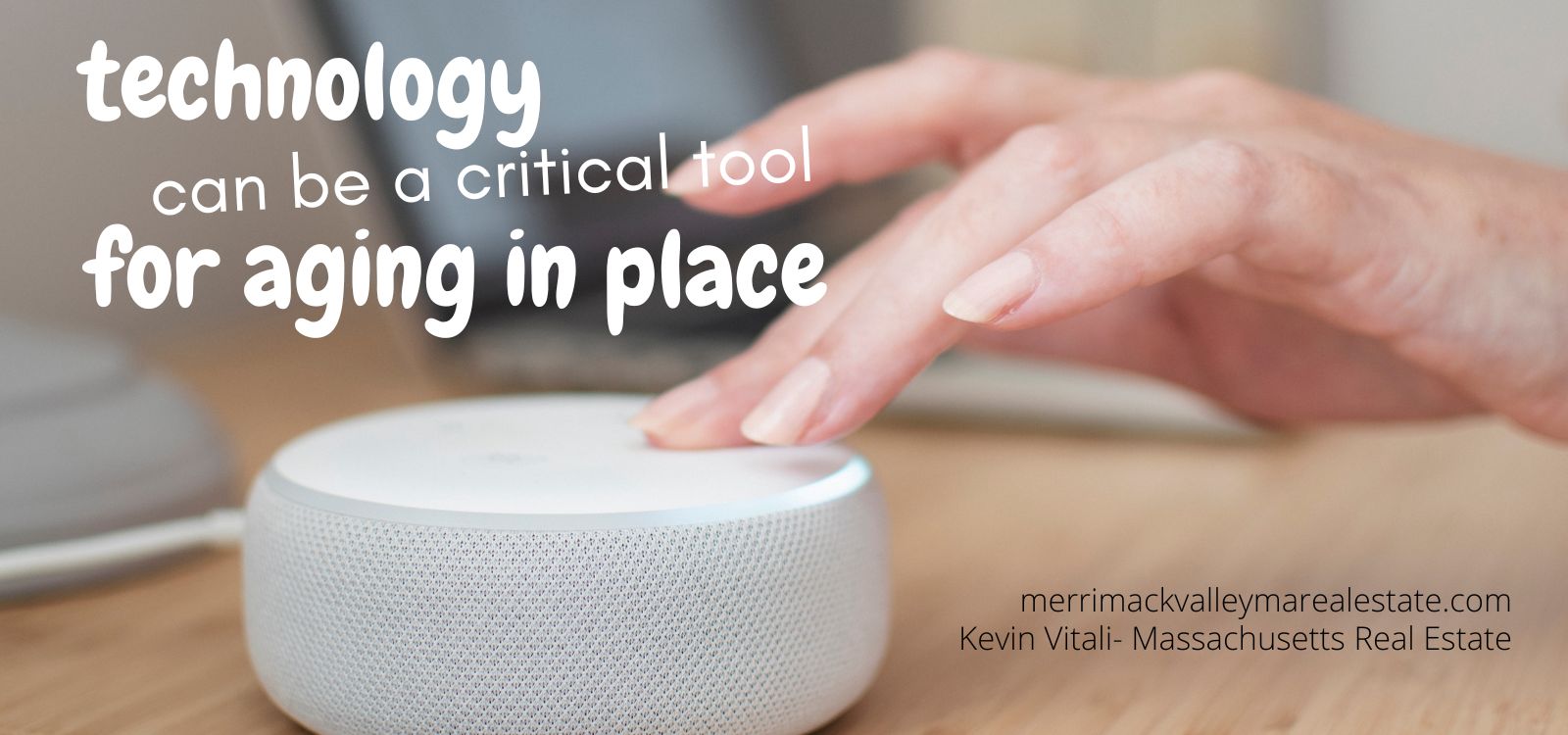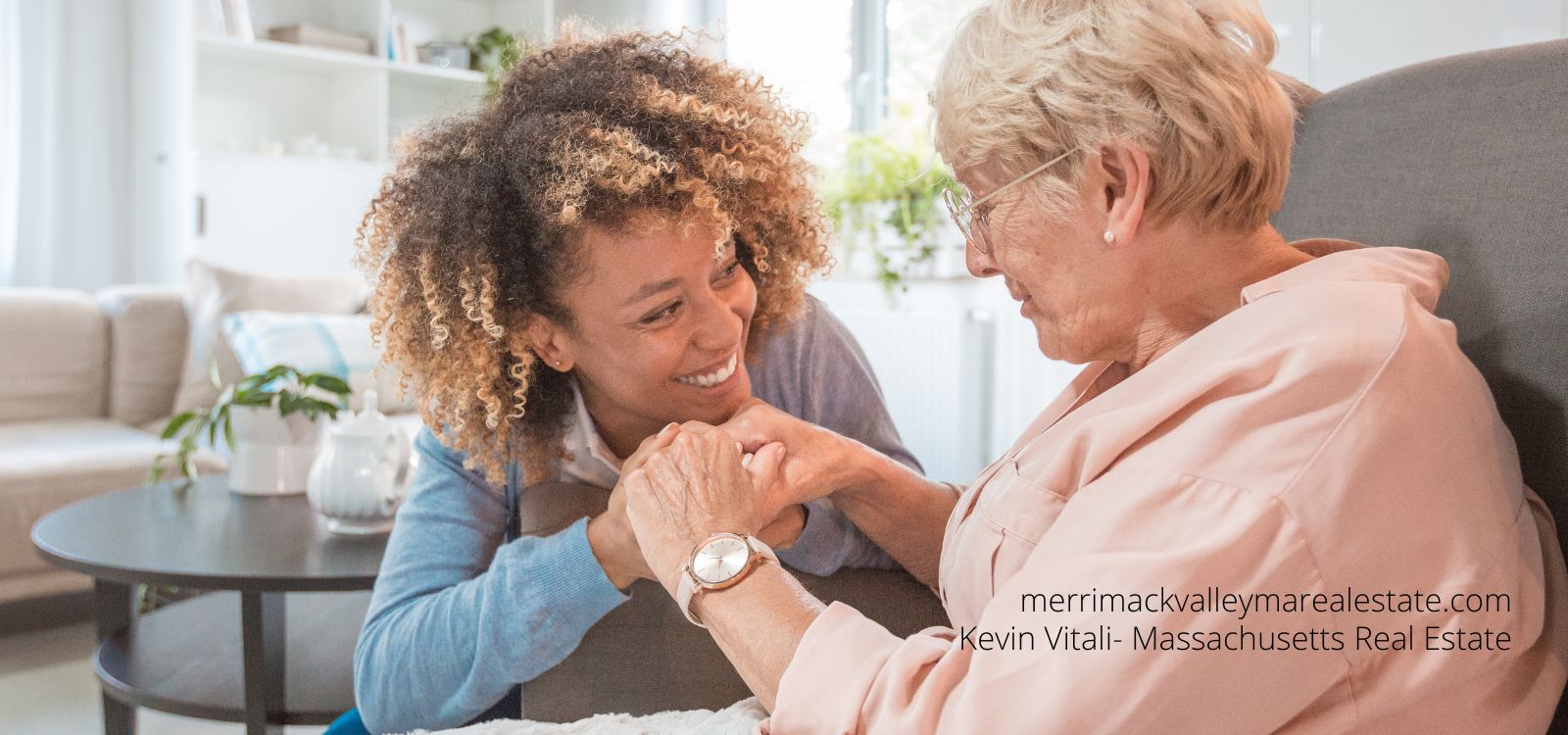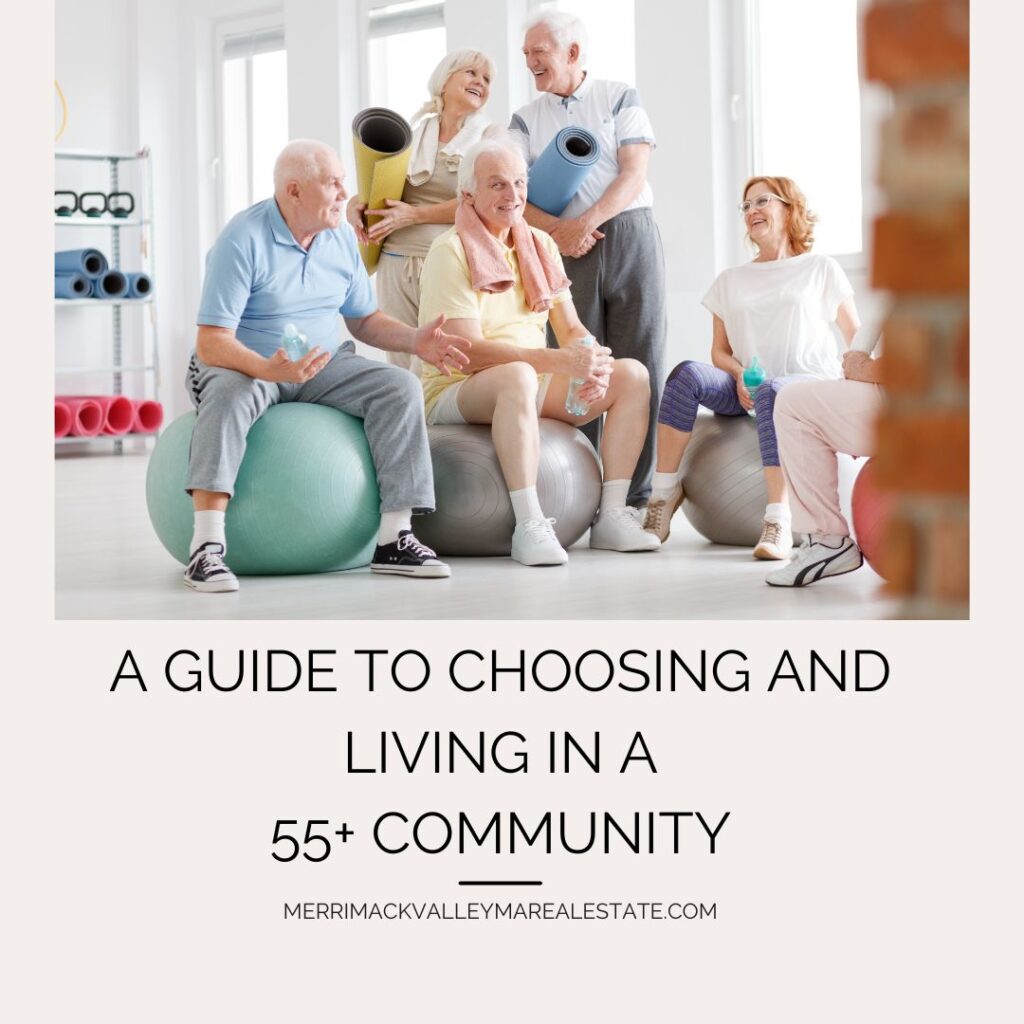
Aging in place is a popular topic as the over-65 population is one of our country’s fastest-growing populations.
The term, Silver Tsunami addresses the baby boomer population hitting 65 at about 11,000 people a day. And the societal changes it will have in the years to come,
As we grow older, our bodies change. This means we must adapt to these changes by making lifestyle adjustments. This may include changes in your living situation, whether creating a move to a more suitable home, downsizing, or making your existing home a perfect way to age in place.
For many people retiring and growing older, it makes them look at their living situation.
- Does downsizing or staying in my current home make financial sense?
- Is my house safe as I age?
- Can I physically and financially keep up maintaining my home?
- Would a new living situation suit me better as I age?
Staying in your current home is an attractive option for many Massachusetts seniors and is what most people consider when discussing aging in place. Your existing home is what you know and love, providing many with a sense of security.
By carefully planning, you may make your existing home one where you can remain independent and gracefully for a long time.
While you can be presented with many different housing options as you age, this article will focus on making your existing home a perfect place to age.
Jump To A Section….
Definition of Aging In Place?
What is aging in place?
Aging in place refers to the ability of older adults to live in their own homes and communities safely, independently, and comfortably, regardless of age, income, or ability level. It’s a concept that has gained popularity as a preferable alternative to institutional care for many seniors.
An Example of Aging in Place
Mary’s journey into aging in place is a blend of practicality and independence. With mobility becoming a challenge, she’s adapted her home to fit her needs, moving her bedroom to the ground floor and organizing her living space to minimize tripping hazards. She’s installed grab bars in key areas, like near stairs and in the bathroom, ensuring she can navigate her home safely.
Realizing the importance of staying active and connected, Mary has also made a smart move by hiring a companion for three days a week. This companion isn’t just help around the house; they’re her link to the outside world, assisting with errands, grocery shopping, and providing a bit of company.
Mary’s approach to aging in place shows that with a few thoughtful changes and some outside help, maintaining independence and enjoying life at home is entirely achievable.
It’s about making adjustments that respect both her desire for independence and her need for safety.
View Homes In Over-55 Communities
an over 55 community can provide a network of neighbors that are in a similar phase of live and provide an active lifestyle
See Homes For Sale Now
The Benefits of Aging In Place for Massachusetts Seniors
A study from AARP shows that 77% of adults over 50 want to stay in their homes long-term.
From an emotional standpoint, those who choose to age in place show higher levels of happiness, satisfaction, and overall well-being. This is partly because staying in a familiar setting helps preserve important personal and social connections, fostering a sense of belonging and community.
Moreover, the continuity of living in a cherished and personal space filled with memories contributes to emotional stability and reduces feelings of stress and anxiety.
Let’s take a deeper look of all the benefits aging in place can provide:
Personal Autonomy and Independence
At the heart of aging in place lies the value of being independent. Having control over daily routines, choices, and the living environment is empowering. It’s about continuing to make your own decisions, from the mundane to the significant, which directly impacts self-esteem and overall life satisfaction.
Emotional Stability and Comfort
The familiar is comforting. Our homes are not just physical spaces but hold memories and personal history. Staying in these environments can provide a sense of continuity and emotional stability, which is particularly grounding as one goes through the aging process.
Social Connections
Remaining in one’s community allows for the maintenance and even growth of social networks. The ability to keep up with friends, family, and community activities is invaluable. These connections are the lifelines of emotional support and engagement, acting as buffers against loneliness and isolation.
Financial Implications
When we talk numbers, aging in place can often be the more economical choice, especially compared to the costs associated with assisted living facilities or nursing homes when one only needs a little help here and there.
With strategic planning, home modifications, and community resources, living at home can be financially sustainable.
When bringing paid help into the home for 12 or more hours a day, it may be time to consider assisted living. At this point assisted living is equal to or less than staying at home.
Flexibility and Personalized Care
Aging in place offers the flexibility to tailor services and care to one’s specific needs. Whether it’s home health care, meal delivery, or transportation services, you can adjust these supports as your needs change, ensuring that the care received is as unique as the individual receiving it.
Community Resources
Many communities are evolving to support aging in place with a variety of services aimed at seniors. From senior centers offering activities and socialization opportunities to local government programs providing assistance, these resources play a critical role in making aging in place a viable and enriching option.
When considering aging in place, it’s important to engage in thoughtful planning and take proactive steps to adapt to changing needs. This isn’t just about staying in one’s home for the sake of familiarity; it’s a deliberate choice to pursue a quality of life that values independence, connections, and personal well-being.
As we consider our own or our loved ones’ journeys through aging, the benefits of aging in place offer a compelling argument for this approach, blending the professional with the personal in a strategy for living well in the later years.
Planning To Age In Place
The key steps to creating a plan to age in place are to assess your current situation and think about future needs. After assessing yourself, please consider the key considerations I lay out.
Assess Your Current and Future Needs When Planning to Age In Place
When charting a course to age in place, giving your personal health a thorough assessment is a cornerstone of the planning process. It’s about understanding where you stand health-wise and anticipating needs that might crop up. Here’s how to tackle this first step:
1. Current and Future Health Status
Kick things off by taking a close look at your current health. Are you managing any chronic conditions, like diabetes, arthritis, or heart disease?
How well are these conditions controlled, and what might their progression look like?
This is about getting a clear snapshot of your health and immediate needs today. But also future needs might be around the corner.
2. Medication Review
Take a deep dive into your medications. Understanding what you’re taking, why, and the potential side effects is key.
Some medications might affect balance or cognitive function, which are crucial considerations for living safely at home and your ability to drive.
It is essential to put a system in place to ensure you take the correct dosage at the right time.
3. Mobility and Physical Function
Assess your mobility and physical function. Can you move around your home easily? Are climbing stairs, reaching overhead, or bending down more challenging?
Mobility is a huge factor in aging in place, influencing everything from home modifications to daily routines.
4. Cognitive Health
Don’t overlook cognitive health. Changes in memory, reasoning, or problem-solving abilities can impact your ability to manage daily tasks and make safe decisions.
It’s about being proactive, recognizing changes, and planning how to address them.
5. Sensory Abilities
Take stock of your sensory abilities – vision and hearing, specifically. Changes in these areas can affect your communication, mobility, and overall safety at home.
Regular check-ups are crucial to catch any changes early and adapt as needed.
6. Emotional Well-being
Your emotional well-being is just as important as your physical health. Consider how you’re feeling mentally and emotionally.
Signs of depression, anxiety, or social isolation should be addressed, as they can significantly impact your quality of life.
7. Risk of Falls
Evaluate your risk of falls – a major concern for aging in place. This includes looking at factors like balance issues, home hazards, and even the side effects of medications.
Planning to minimize this risk is a critical part of your health assessment.
8. Healthcare Access
Consider your access to healthcare services. Is your current healthcare team supportive of your aging-in-place plan? How will you access medical care, especially if mobility becomes an issue?
Telehealth and in-home health services might be pieces of the puzzle to get the healthcare you need.
9. Preventive Care
Stay on top of preventive care. Regular check-ups, screenings, and vaccinations can keep minor issues from becoming major ones.
Take preventative care seriously and stay one step ahead,
By taking a detailed look at these aspects of your health, you’re not just preparing to age in place; you’re setting the stage for aging well.
This isn’t about dwelling on what might go wrong but ensuring you have a plan that supports your health, safety, and happiness as you navigate the years ahead.
It is much easier to plan and put preventative measures in place before its needed rather than when something happens and it’s a must.
Age in Place: Be Realistic About Your Situation
Looking at the potential of losing some level of your independence and some physical and cognitive capabilities is undoubtedly scary. By not being realistic about your current circumstances, you can create problems that you don’t want.
It is vital to get ahead of your aging-in-place plan. This gives you time to find solutions that work for you where you still have control over your destiny.
A hospital stay from an injury sustained from falling or tripping can lead to events that cause you to be reactionary and make rushed decisions. Or worse, medical professionals prevent you from going home because they feel you are not safe.
My Own Story

My mother passed away a few years ago and I had put many things in place to allow her to live at home as her body deteriorated. I did it all: grab bars, lift chairs, ramps, modifying layouts, medical beds and equipment for infusions, visiting nurses, hiring a full-time CNA, and more…
My father is in his mid-80s and suffers from moderate dementia. Between my mother and father, my mother was sharp as a tack, and my father was relatively physically capable; they made one person together. And, my mother was the only person that could keep him in check and make him do things he didn’t want to do.
My Fathers Inability To Be Realistic
I had planned to keep much of what I had in place for my father at home. Before the funeral home even arrived, he had kicked the CNA out of the house and told me he wanted everything put back the way it was. Medical beds are gone, lift chairs are gone, throw rugs are back in place, etc.….
My father refuses to use a cell phone, wear a medic alert bracelet, install video cameras, use a lift chair and a much-needed cane or walker. The list goes on. As much as my brothers and I tried, he refused any help and ignored doctors’ recommendations (use a cane and stop driving).
Over the next 11 months, it became pretty apparent that my mother had compensated him more than we realized. He wasn’t taking meds properly, he wasn’t feeding himself well, his hygiene was not what it should be, and he was still driving! He was not aging in place gracefully. And when confronted by me and my brothers or doctors, he screams, “That’s bull!.”
Finally, he had a bad fall. After my younger brother and I could not reach him, we decided to go check. He fell and was left flat on his face for over 24 hours. It wasn’t pretty.
Subsequently, he spent four months in and out of the hospital, rehab and the recommended memory care.
If My Dad Was Realistic About His Limitations, It all Could Have Been Avoided
It all could have been prevented if he had been practical and realistic about his abilities and needs. If he used a lift chair, and if he did fall and he had a medic alert bracelet or we had cameras in place, he would have probably not had to go to the hospital, and he would still be at home.
The point of this story is because my father was not realistic about his circumstances, decisions are being made for him. No medical facility will release him without a care plan in place that requires 24-hour care. While that could be possible, we collectively feel he will drive out any CNAs we put in place, continue to drive and make bad decisions.
Being realistic about your situation and needs is essential to keeping your independence and remaining in your home.Ag
The Key Considerations When Deciding to Age In Place
There are two crucial facts to consider when considering the critical considerations to age in your home.
First, the same AARP survey I referenced above found that while most older adults prefer to age in place, only about 1 in 3 (32%) believed their home had the necessary features to do so safely and comfortably.
Second, falls are not just expected; they are the leading cause of injury and injury-related deaths among older adults. The statistics are quite telling, with the Centers for Disease Control and Prevention (CDC) reporting that one in four Americans aged 65 and over falls yearly.
This indicates a significant need for home modifications and community-based support services should be key considerations when deciding to age in place.
Let’s look at all the considerations to be factored into your decision to remain in your Massachusetts home:
Home Safety and Accessibility
Make modifications to the home to ensure it is safe and accessible. This can include installing grab bars in bathrooms, ensuring no trip hazards, improving lighting, and possibly remodeling to accommodate single-floor living.
A fall for anyone can have serious consequences, but for the elderly, they are particularly life-threatening. Many times, as I work with seniors and their living situations, a fall is generally what gets a client to call me.
Health and Wellness
Maintaining physical and mental health through regular medical check-ups, a balanced diet, exercise, and social engagement. Access to health care can be a critical aspect of staying in the home.
Consider how easy it is to get to the doctors or critical care and access in-home health care, and for smaller issues, consider telehealth. As you age, visiting the doctor becomes more often and can be critical to maintaining your health.
Social Support and Community Engagement
Staying connected with friends, family, and community activities to prevent social isolation is important. This might involve participating in local senior centers, volunteer activities, or online communities. A companion can also be hired to play games, do puzzles, and connect regularly.
Socialization is critical and helps prevent loneliness and isolation. Do not underestimate the value of staying connected. It is vital to most people’s well-being.
I had an older woman who literally lived 1.5 miles from her church and 2 miles from the grocery store but stopped driving. My client felt so isolated. She regretted missing out on her church services and activities. And, her 3 or 4 times a week to shop was a way to get out. Subsequently, I contacted the church and arranged for church members to provide transportation for her. Ultimately, I helped sell the family home and transition her into assisted living.
On my follow-up with her, she said it was the best move ever, and it all had to do with socialization.
Transportation
Ensuring there are options for mobility when driving is no longer safe or possible. This could involve access to public transportation, rideshare services, community shuttles, or assistance from family and friends.
Some may be comfortable driving around town during the day as they age. But getting on the highway or driving at night is no longer possible. So, while a senior may retain their license, there may be times they need transportation assistance.
Figuring out transportation is essential to getting to and from medical appointments and maintaining social engagement, both vital to one’s well-being.
Financial Planning
Securing the financial resources needed to cover home modifications, in-home care services, and other expenses associated with living independently. This might involve consulting with a financial advisor to explore options like reverse mortgages, long-term care insurance, or government assistance programs.
When working with some clients, I have found them struggling to pay bills and even provide themselves with proper nutrition. Often, they have little or no income coming in, but they are sitting in an expensive home. Selling the house gives them plenty of money to transition into a different living situation without worrying about paying the bills or their next meal.
I had her work with a financial advisor, and a decision was made to move her into a less expensive over-55 condo. The rest of the proceeds from the sale of her home would fund her retirement for many years to come.
Be pragmatic about the financial situation. Not one solution fits all.
Technology
Technology is a game changer for many aspects of our lives. And, it certainly can be helpful for those aging in place.
Utilizing technology to support independent living, such as emergency response systems, medication management devices, and smart home technologies that can automate tasks and improve safety.
Aging in Place Scenario
Mom is sitting in her lift chair, where she doesn’t have to struggle to get up and down. The visiting nurse rings the door, and she can unlock the door from her smartphone or smartwatch.
Her smart watch can remind her when to take medication, she can respond to phone calls and it even has fall detection.
Technology can be a game changer in the aging-in-place arena.
Simple smart devices that can help you with your ability to age in your current home are:
- Smartwatches- With a smartwatch, you can do many things you can do with a smartphone. It allows you to monitor texts, receive and make calls, provide reminders, and more.
- Smartphones- Everything comes with an app these days. You can control smart locks on your doors, lighting, and automatic blinds.
- Alexa or Google Home- These devices can allow you to access information or make calls with out getting up to go to a computer or get the phone.
- Doorbells with video cameras.
- Smart locks are to be locked and unlocked with a smartphone.
- Video cameras. While it may seem intrusive, a video camera where you spend your waking hours lets family members know your routine and see when something isn’t right.
- And the loss goes on….

Legal and Advance Planning
When you start thinking about aging in place, it is an excellent time to assess and review your legal documentation or even put it in place if you haven’t.
A medical situation or just aging can leave you partially or fully incapacitated, making it hard to know what your wishes are. Legal documents such as a will, durable power of attorney, and healthcare directives ensure personal wishes are respected, and financial matters are handled according to one’s desires.
Community Resources
Explore local resources and services that support aging in place, such as meal delivery programs, in-home care providers, and aging-in-place advisors or coordinators. There are more services out there than you may realize that will help you stay in your home as you age.
By addressing these considerations, older adults can increase their chances of successfully aging in place, maintaining their independence, and enjoying a high quality of life as they age. Everyone’s situation is unique, so it’s vital to assess needs and resources carefully and make plans that best suit one’s circumstances.

The Importance Of Remaining Flexible
Embracing flexibility when aging in place is like keeping a Swiss Army knife handy in your toolkit for life’s later years. It’s about being prepared to adapt to changes, both expected and unexpected. Ensure that your plan for living independently remains not just viable but vibrant. Here’s why staying flexible is a game-changer:
Adaptability is Key to Overcoming Challenges
As we age, our needs, abilities, and health status can shift, sometimes subtly, other times more dramatically. A home setup or care arrangement that works perfectly today might need tweaking tomorrow. Being open to adjustments—whether it’s modifying your living space, changing your care services, or even altering your daily routines—can make all the difference in maintaining your quality of life and independence.
Technology and Services Evolve
The landscape of aging in place is continually evolving, with new technologies, services, and community resources emerging all the time. Staying flexible means you can take advantage of these innovations as they become available, from the latest in telehealth services to smart home gadgets designed to make life easier and safer.
Social and Emotional Needs Change
Just as our physical needs evolve, so too do our social and emotional ones. The activities and social circles that fulfill us at one stage of our lives may change. Flexibility in how we engage with others, pursue interests, and even where we find our community can lead to richer, more satisfying golden years.
Financial Realities
Let’s face it, financial situations can change. The cost of living, healthcare expenses, or changes in income can all impact your ability to age in place. A flexible approach to budgeting and financial planning, including being open to exploring assistance programs or alternative care options, can help navigate these shifts.
Health Care Needs are Not Static
Our health care needs tend to become more complex as we age. Being flexible in how we approach and manage our health—whether that’s being open to new treatments, adjusting to new routines, or even shifting our care providers—can enhance our well-being and ability to stay at home.
In essence, flexibility when aging in place is about embracing change as an integral part of the journey, not an obstacle to it. It’s the recognition that the goal isn’t just to stay in one place physically but to thrive there, no matter what life throws your way. By adopting a mindset that welcomes adaptation, you’re not just planning to age in place; you’re planning to age with grace, resilience, and joy.
When Should You Start Thinking About Aging In Place?
Thinking about putting a plan in place to age in your own home isn’t just for those reaching their golden years; it’s a smart move at almost any stage of adulthood. In essence, the best time to start planning is sooner rather than later. Here’s why early planning makes sense and when specifically you might want to start giving it some serious thought.
In Your 50s: The Initial Wake-up Call
Your 50s are often when retirement planning becomes more pressing, and it’s also a good time to start thinking about how and where you want to live as you age.
This decade is typically marked by a mix of stable income and relatively good health, making it an ideal time to consider future needs. Start envisioning what aging in place might look like for you and begin assessing your home for long-term livability.
As You Approach Retirement
Approaching retirement is a milestone that brings the reality of aging into sharper focus. It’s a period when you might have more clarity about your financial situation and can more accurately gauge what modifications your home might need.
This is also a time to think about the kind of support you might want down the line, from community resources to in-home care options.
When Health or Mobility Concerns Begin
Sometimes, the need to think about aging in place comes with the onset of health or mobility issues, either for yourself or a loved one.
Even minor concerns can serve as a prompt to evaluate your living situation. It’s about not just adapting to current needs but anticipating future ones.
Following Major Life Changes
Major life events, such as the loss of a spouse or significant changes in income, can also trigger the need to plan for aging in place. T
hese events often bring practical considerations about living arrangements to the forefront and can be a good time to reassess your plans with a fresh perspective.
Any Time You’re Ready
Truthfully, there’s no such thing as too early when it comes to planning for your future. Even if your plans change (and they likely will), having a flexible strategy in place can provide peace of mind and a sense of preparedness.
Starting to plan for aging in place before it feels urgent allows you to approach the process thoughtfully and thoroughly, making decisions based on what you truly want rather than what circumstances might dictate. It’s about setting the stage now for a future where you can live on your terms, surrounded by the comforts of home and community.
Everybody ages differently, some start to feel effects in their 50s while other may not start to feel them until their late 60s. Eventually it does catch up to you.
So, if you’re wondering when the right time to start is, it might just be today.
Family Support Can Be A Critical Aspect Of Aging In Place
Discussing your plan and your need for help with family members can be essential to your aging-in-place plan, especially for adult children.
Garnering their support can mean various things: regular wellness calls or visits. helping you implement part of your plan. And certainly helping organize support services.
I know with my mother, coordinating with the home health care company to ensure round-the-clock care was a part-time job. As my mother weakened, it was not a task she could do alone, nor was my father up to.
Don’t overlook the importance of the support of family and friends, especially as your needs grow.
Home Health Care Can Be A Vital Component Of Aging At Home
Once one gets past the stage of doing it on their own, home health care will be a vital role in staying independent longer at home. It could be as simple as someone coming in to help bathe a few times a week help sort medications or include round-the-clock care. There are so many services available to aid in home health care. Assess your needs and do your research. Many communities have visiting nurses you can tap into or there are home health care companies that can provide a concierge of services. Do your research and tap into a multitude of services that you or your loved one can access.
Maybe Aging In Place Isn’t For You- What’s Your Alternatives?
For various reasons, aging in your current home may not be viable. It could be for financial reasons, your current home is not conducive to staying as you age, or maybe you don’t feel safe at home and need a higher level of care. Let’s look at some options.
- Downsizing Your Home- Downsizing your home can provide more space conducive to independent living as you age. It can also offer less ongoing maintenance. Or maybe it frees up cash to help fund your retirement.
- Over-55 Community- An over-55 community can provide tons of socialization, and you are surrounded by people in the same life stage. It delivers a lifestyle. You might maintain the same size home or again choose to downsize and simplify.
- Live With A Family Member- Multi-generational living is becoming more popular for various reasons. Parents moving into in-law apartments in their adult children’s homes can benefit each party, especially sharing costs and reducing expenses. And for the seniors, there is support available when needed.
- Independent Living Facility- At some point, you might not feel safe alone or need more services than you can afford at home. In independent living facilities, you can maintain complete independence and choose from a list of concierge services as your needs change. But there will always be someone around to assist you no matter what.
- Nursing Home- If you require around-the-clock care, your only option may be a nursing home. A nursing home is for someone who cannot do much of anything to take care of themselves.
Aging In Place Resources To Consider
There is a multitude of resources on aging. Here are just a few:
- Meals on Wheels Meals on Wheels can provide daily meals for you temporarily or long term at a very low cost
- Council on Aging Many communities have a council on aging that can be a great resource in tapping into local services for those over the age of 60.
- AARP A national organization that brings you some great information about living your best life as you age.
- National Council on Aging A national organization with tons of support and resources for adults as they start to age.
- Care.com A resource to find in home care. Housekeepers, rides, and licensed healthcare professionals can be found to help you find the services you need.
- Instacart A grocery delivery service that will deliver to your door. Use them occasinally or for every shop!
- In Home Health Care Agencies- Google in home health care agencies for a start to finding in home health services.
- Your Town or County Visiting Nurse Association
Summary On Aging In Place
To help avoid age-related problems and improve the quality of life, it is important to start taking steps now to prepare for them. Aging in place means living as comfortably and independently as possible within your current environment.
There are many things that you can do to make your home more accessible and comfortable, such as modifying the layout of your home or getting help from family or friends. However, there may be some gaps in your knowledge or need for assistance that you should address before moving forward with aging in place preparations.
Aging in place means living comfortably where you are now while making adjustments where necessary due to changing needs to live a happy healthy life.
Other Real Estate Resources:
- An appraisal contingency is a clause in a real estate contract that prevents a buyer from overpaying for a property. Bill Gassets explains the difference between an appraisal contingency and a mortgage contingency.
- As a home buyer you may be considering buying new construction vs a resale home. Sharon Paxson discusses the pros and cons of buying new construction.
- How can a sellers disclosure help you sell your home? Michelle Gibson discusees everything a seller should know about the seller’s disclosure.
- Selling a large multi-unit building is different than selling a single family home. Paul Sian discuses some of the best practices of selling a multi-family home
Do you need help making living decisions as you approach your golden years? I am here to help. We can discuss living in your current home and what that entails, downsizing, moving into an over 55 community or assisted living. Leet me help you make the right decision.




